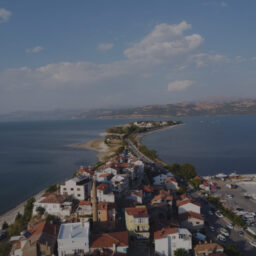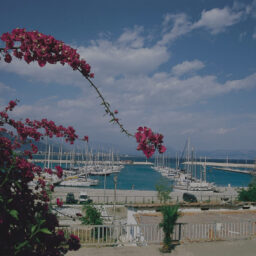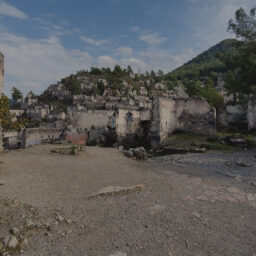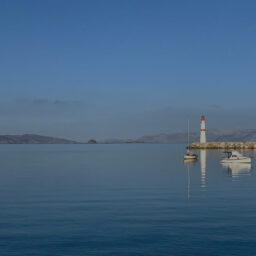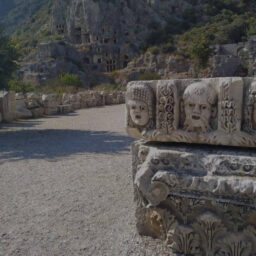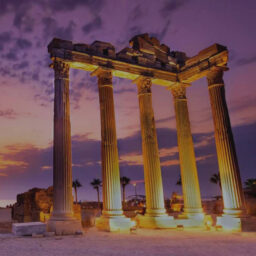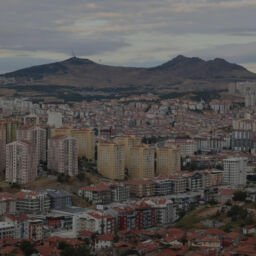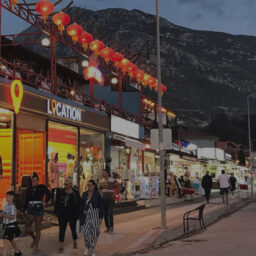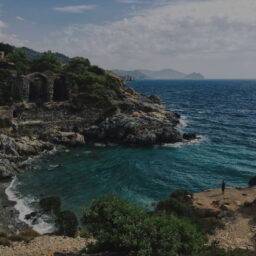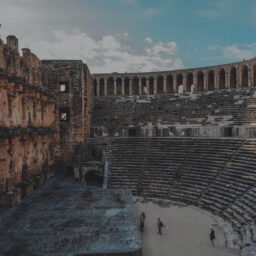History of Fethiye: From Ancient Times to Present
Fethiye is a charming town in Turkey, known for its turquoise blue waters and rugged natural landscapes.
Situated on the south-western coast of Turkey, Fethiye borders the Mediterranean Sea.
The town is one of the most significant tourist destinations in Turkey due to its natural beauty and historical significance.
Understanding Fethiye’s Location and Significance in Turkey
Fethiye is situated on the northern side of a gulf that goes by its name, which opens up to the Mediterranean Sea.
The town is also positioned at the heart of Lycia, an ancient region that existed between Caria and Pamphylia.
Today, Fethiye lies within Mugla Province’s boundaries and borders with Antalya Province to its east.
The town enjoys an exceptional climate throughout the year with mild winters and long summers with hot temperatures.
Its natural harbor was once used as one of Lycia’s major ports centuries ago due to its strategic location on trade routes between Greece, Egypt, Cyprus, Italy, Syria, and Phoenicia.
The Importance of Understanding Fethiye’s History
It can be fascinating to learn about a place’s history since it helps us understand how it has evolved over time.
Fethiye has seen many civilizations come and go over time – from Lycians to Greeks, Romans to Ottomans – each contributing their unique cultural significance to this serene coastal town.
Learning about Fethiye’s vibrant past can help visitors appreciate every aspect of their experience there- from tasting traditional cuisine influenced by past grazing practices or admiring architecture that combines Greek-Roman-Ottoman styles.
It also reminds us that we are not separate from those who have come before us but rather a part of an enduring legacy that stretches back thousands of years.
Overall, understanding Fethiye’s history is essential to appreciate the town’s present and future significance in Turkey.
Early History of Fethiye
Prehistoric Settlements in the Area
Fethiye’s history dates back to prehistoric times. The area around Fethiye has been inhabited since the Neolithic period, and archaeological evidence suggests that the region was home to several different cultures during this time.
Excavations in the area have uncovered remains from the Bronze and Iron Ages, including stone tools and pottery.
Influence of Lycian Civilization on the Region
The Lycians were an ancient civilization that thrived in southwestern Anatolia from 1200 BC to 300 BC.
They are known for their distinctive rock-cut tombs and elaborate funerary architecture.
The Lycians had a significant influence on Fethiye’s history and culture, particularly during the Classical period.
Several Lycian cities were located within close proximity to modern-day Fethiye, including Tlos, Pinara, and Xanthos.
These cities played important roles in regional trade and were known for their artistic achievements. Today, visitors can explore the ruins of many Lycian cities near Fethiye.
Greek and Roman Periods in Fethiye
During ancient Greek times, the region around what is now Fethiye was part of Lycia.
Later, under Roman rule (from approximately 43 AD), it became part of Asia Minor Province.
Famous Greek historians Herodotus (5th century BC) and Strabo mention Telmessos as one of six leading cities of Lycia while other writers states that Macry was an important center for worshiping Artemis.
During Hellenic period with Alexander’s conquests Telmessos became part of Hellenistic kingdom ruled by Ptolemy’s successors who maintained control until Mithridates VI of Pontus conquered the area in 88 BC.
Ottoman Era in Fethiye
Conquest by Ottoman Empire and establishment as a district center
Fethiye was conquered by the Ottoman Empire in the 15th century, and it became an important district center.
The Ottomans strengthened the infrastructure of Fethiye and established trade routes that helped to boost economic growth in the region.
They also built important architectural landmarks that still exist today.
Development of trade routes and economic growth under Ottoman rule
The Ottomans recognized the importance of Fethiye’s strategic location on the Mediterranean coast.
They established trade routes between Europe, Asia, and Africa that passed through Fethiye, making it an important hub for commerce.
Merchants from all over the world came to Fethiye to buy and sell goods, which led to significant economic growth in the region. During this period, agriculture was a key industry in Fethiye.
The fertile soil allowed for the cultivation of olives, citrus fruits, grapes, and cotton.
The production of cotton became especially important during World War I when it was used to make uniforms for soldiers.
Architectural landmarks from this period, including mosques and caravanserais
The Ottomans left their mark on Fethiye with impressive architectural landmarks such as mosques and caravanserais. One of these is Paspatur Mosque which dates back to 1795.
It has an intricately designed mihrab (prayer niche) made from marble. Another notable landmark is Han Mosque in Kayaköy village which was built as a caravanserai (inn) in 1840 before being converted into a mosque later on.
Serving as both places of worship and community centers where people gathered to socialize or conduct business, mosques were integral to daily life in Fethiye.
They were often built with impressive domes and minarets, such as the stunning Şefika Sultan Mosque built in 1860.
Alongside mosques, caravanserais provided a place for traders and their animals to rest during long journeys, with food, drink, and accommodation available.
The architectural landmarks of Fethiye from this period continue to stand today as a testament to the Ottoman Empire’s influence in the region.
Modern History of Fethiye
Impact of World War I on the region
World War I brought significant changes to the region, including Fethiye. After the Ottoman Empire entered the war in 1914, Fethiye became a strategic location due to its proximity to the Mediterranean Sea.
The port of Fethiye was used as a base for German submarines, which posed a significant threat to Allied shipping in the area.
As a result, British and French naval forces attacked and destroyed several targets along the coast of Fethiye during the war.
During this period, many local residents were conscripted into service by Ottoman authorities, leading to loss of life and economic instability.
Furthermore, as a result of increased military activity in the area, many villages and towns were evacuated or abandoned entirely. The impact of World War I had profound effects on Fethiye’s population and economy.
Changes during Turkish War of Independence
Following World War I, Turkey underwent significant political upheaval with Mustafa Kemal Atatürk leading a nationalist movement that aimed at establishing an independent Turkish state.
The Turkish War of Independence began in 1919 with widespread fighting across Anatolia.
Fethiye played an important role during this period as it served as an important axis between Antalya and Mugla regions.
Many battles took place around Fethiye with several historical buildings destroyed or damaged during the conflict.
After Turkey gained independence in 1923 under Atatürk’s leadership, reforms were introduced that aimed at modernizing Turkey’s economy and society.
Growth as a tourist destination in the 20th century
In recent years Fethiye has experienced tremendous growth as a tourist destination due to its unique natural beauty and rich cultural history.
The town attracts visitors from all over the world who come to enjoy its sandy beaches, crystal-clear waters, and breathtaking natural landscapes.
Today, Fethiye is a thriving resort town with modern infrastructure and an array of amenities.
The growth of tourism has had a significant impact on the local economy, creating jobs and generating revenue for businesses in the area.
Despite this growth, however, efforts are being made to preserve the town’s cultural heritage and protect its natural environment.
As a result, Fethiye remains an ideal destination for those seeking to experience both Turkey’s traditional culture and its modern amenities.
Cultural Significance of Fethiye
Local Customs, Cuisine, and Traditions
Fethiye is known for its rich cultural heritage, reflected in the customs, cuisine, and traditions of the local people.
One of the most notable customs is the annual Lycian Way Ultramarathon. This event was established in 1999 to promote tourism in Fethiye.
It takes runners along 540 km of Lycian roads over a period of 6 days. The race has gained popularity over the years and now attracts participants from all over the world.
Cuisine is also an essential aspect of Fethiye’s culture. Many traditional Turkish dishes are popular here, including meze (which consists of small dishes served as appetizers), köfte (meatballs), and gözleme (thin pastry filled with meat or vegetables).
Fresh seafood is also widely available due to Fethiye’s location on the Mediterranean coast. In addition to food, there are various local crafts like carpet weaving that have been passed down through generations for centuries.
Arts, Music and Literature
Fethiye has a long history as a center for arts, music, and literature. Artists from all over Turkey come here to seek inspiration from its natural beauty and rich cultural heritage.
One example is Aksazlar Beach Art Village which hosts workshops every summer season with artists invited from all around Turkey.
Folk music is another tradition closely associated with Fethiye’s cultural identity that has been passed down through generations for centuries.
Genres such as Karsilama (a Turkish folk dance) are still performed during local festivals today.
In addition to music and artistry, literature also has a significant impact on contemporary Turkish society thanks to writers like Vedat Günyol who wrote “Yasar Kemal’in Sesi” (The Voice of Yasar Kemal).
Günyol’s work on the famous Turkish writer Yasar Kemal has been critical in promoting Turkish literature both domestically and internationally.
Fethiye is known for its rich cultural heritage, reflected in the customs, cuisine, and traditions of the local people.
The town’s role as a center for arts, music, and literature has had an enormous impact on contemporary Turkish society.
Conclusion
Throughout its history, Fethiye has been a hub of cultural activity and economic growth.
From the prehistoric settlements to the Ottoman conquest, and from the wars of the 20th century to its current status as a tourist destination, Fethiye has undergone significant changes while still retaining a unique cultural identity.
Preserving this rich heritage is essential for the future of Fethiye and for Turkey as a whole. One of the most significant aspects of Fethiye’s cultural heritage is its architecture.
From ancient Lycian tombs to Ottoman mosques and caravanserais, these structures tell stories of their respective eras and offer insight into past societies.
Many of these buildings are in danger of deterioration or loss due to neglect or modern construction projects.
Preserving these architectural landmarks will help future generations understand their history and appreciate their aesthetic value. Another aspect that should be preserved is local customs, cuisine, and traditions.
Fethiye’s cultural identity is deeply rooted in its people’s way of life, which includes traditional music, dance, and festivals.
Local cuisine boasts unique dishes using fresh ingredients from the region’s fertile soil and Mediterranean waters.
These customs are at risk due to globalization trends that promote homogenization instead of diversity. Preserving these traditions will ensure that future generations have access to this rich heritage.
Understanding Fethiye’s history is essential for appreciating its significance within Turkey’s cultural landscape.
By preserving historical landmarks, local customs, cuisine, and traditions we can ensure that future generations can learn from the past while enjoying a vibrant present full of diverse cultures intertwined together by time-honored traditions passed down through generations – truly embracing what makes us all human in one world connected by our shared pasts and futures!
Why is Fethiye's history important?
Fethiye's history provides insight into its evolution over time, including influences from various civilizations. It helps visitors appreciate the town's cultural significance, architecture, cuisine, and future potential.
Who were some of the major civilizations that impacted Fethiye?
Fethiye has seen influence from several civilizations, from Lycians to Greeks, Romans to Ottomans. Each has contributed to Fethiye's cultural heritage and architectural style.
How did the Ottoman Empire affect Fethiye?
The Ottoman Empire established important trade routes, strengthened Fethiye's infrastructure, and built architectural landmarks. It significantly boosted the region's economic growth and left a lasting architectural imprint.
What is Fethiye known for today?
Today, Fethiye is known as a significant tourist destination, famed for its natural beauty and rich history. It has a thriving resort town reputation while preserving its traditional culture and heritage.












